Apollo 13
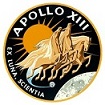
Day 6, part 8: The Blackout, Splashdown and Recovery
Corrected Transcript and Commentary Copyright ©2020 by W. David Woods, Johannes Kemppanen, Alexander Turhanov and Lennox J. Waugh. All rights reserved.
Last updated 2020-04-27
Apollo Control, Houston; 141 hours, 35 minutes now into the flight. We have reports from recovery that Samoa rescue Aircraft, 1, 3 and 4 are now en route to their respective stations. These C-130 aircraft; Samoa 1 will be positioned 105 nautical miles uprange. Samoa 4, 200 nautical miles downrange. Correction to that last report Samoa 1 will be 345 nautical miles uprange. Samoa 2, 240 nautical miles uprange. Samoa 4, 200 nautical miles downrange. Continue to monitor at 141 hours, 36 minutes; this is Apollo Control, Houston.
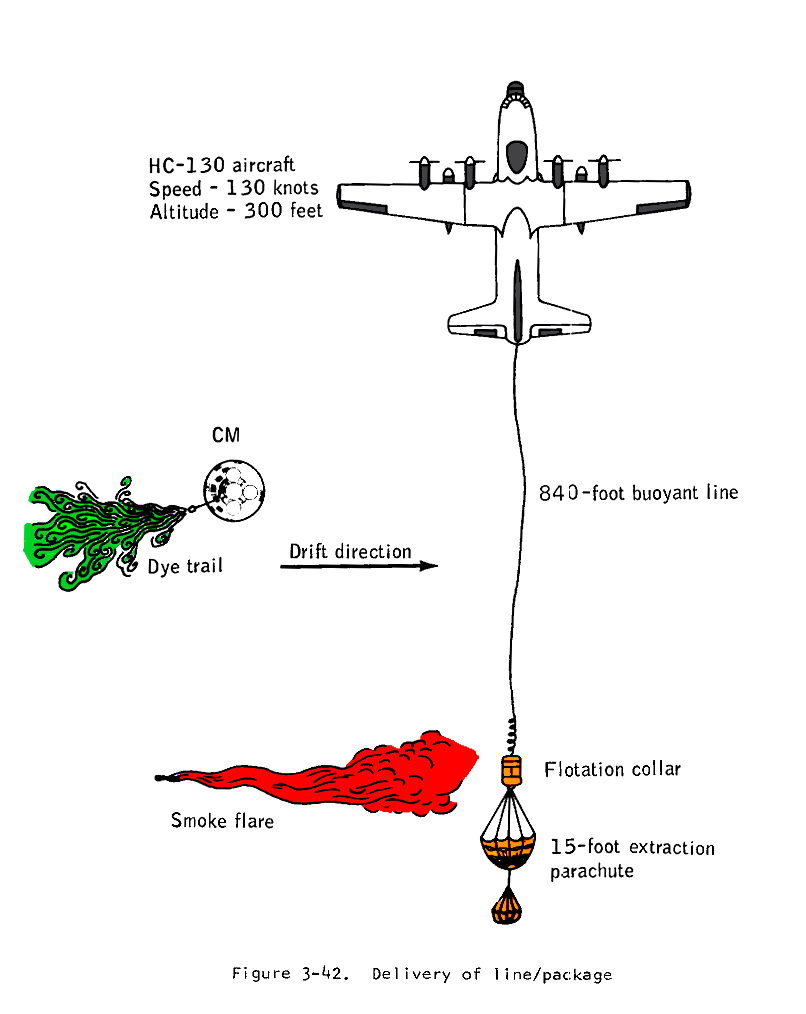
Diagram of the long range plane rescue plan. The Command Module can signal its position via a radio beacon, a dye marker, and a flashing strobe light. The search plane can drop a bundle of equipment attached to a long floating rope the Command Module crew can snatch using a hook stowed onboard.
141:36:03 Kerwin: Odyssey, Houston.
141:36:05 Swigert: Go ahead.
141:36:06 Kerwin: Okay, Jack. We'll have a PAD for you in a few minutes. We're getting data now on the tracking, and although we suspect the changes from your preliminary PAD will be very small, we recommend that you hold off on initializing the EMS until we get you the final PAD. Over.
141:36:23 Swigert: Okay. Will do.
141:36:25 Kerwin: Roger. [Long pause.]
141:37:20 Swigert: Okay, Houston. The sextant star check passes.
141:37:23 Kerwin: Houston, copy. Good show. That was some P52, Jack.
141:37:35 Swigert: Yes. I was kind of lucky, I guess.
141:37:41 Kerwin: Give you a big gold star for that.
141:37:44 Swigert: Thank you. [Long pause.]
141:38:15 Swigert: Hey, Joe. We're standing by to copy your new PAD.
141:38:18 Kerwin: Okay, Jack. It'll be a few minutes yet. We want to get it right up to speed. [Long pause.]
141:38:43 Swigert: Okay. I can proceed with EMS check, can't I, Joe?
141:38:46 Kerwin: That's affirmative, Jack. You can go ahead with that.
This is Apollo Control, Houston; 141 hours, 40 minutes now into the flight of Apollo 13. Apollo 13 now at an altitude of 9,703 nautical miles from Earth with a velocity now reading 18,504 feet per second. We have a report that the Lunar Module is continuing to hold attitude the way it should. Cabin pressure is holding and here in Mission Control, we'll continue to track the Lunar Module Aquarius until it reenters. We're at 141 hours, 41 minutes into the flight; and this is Apollo Control, Houston.
This is Apollo Control, Houston at 141 hours, 44 minutes now into the mission. Apollo 13 presently at a distance of 9,102 nautical miles from Earth and with a velocity reading 18,952 feet per second. Meanwhile we have a listing of the crew members of the helicopters who will be airborne at the time of predicted landing. We read an estimated time of landing now of 1 hour, 10 minutes.
Aboard Recovery 1 Pilot will be Commander Charles B. Smiley, 39, of Oklahoma City, Oklahoma. Commander Smiley is the H-S4 Commanding Officer and picked up the Apollo 10 astronauts. Co Pilot Lt. Junior Grade Dana G. McCarthy, 25, of Chathum, Mass. First crewman, Ralph G. Slider, 28, of Paden City, West Va., Second crewman, Michael Longe, 21, of Shelburn, Vermont. The swimmer aboard, Lt. Junior Grade Ernest Lee Jahncke, 26, of Greenwich, Connecticut. Aboard Swim 1; Pilot Lt. Commander Carl John Frank, 35, North Merrick, New York, Co Pilot Lt. Jr. Grade Douglas Fillmore Hudson, Jr., 24, of Barrington, Illinois. First crewman, Robert Peterson, 23, of Susanville, California, Second crewman, Gary W. Neilson, 21 of Delhi, Louisiana. Swimmer, Stephen P. Jewett, 25 of Ontario, California, and Second swimmer, Robert J. Pfanzelter, 19, of Burlington, Wisconsin, Third swimmer, Luco Palma, 19, of Tewksbury, Mass.
141:46:48 Kerwin: Odyssey, Houston. Over.
141:46:51 Lovell: Go ahead, Houston.
141:46:53 Kerwin: Okay, Jim. Your cabin is looking real good. We recommend you turn the Suit Compressor to Off now. Over
141:47:00 Lovell: Going Off. Boy, it's nice and quiet in here. [Pause.]
141:47:09 Kerwin: Okay, real good. Incidentally, your power is looking real good also, Jim.
141:47:16 Lovell: Thank you. [Long pause.]
Aboard Swim Helicopter No. 2; Pilot Lt. Allen Leroy Willhite, 27, Oklahoma City, Oklahoma. Co Pilot Lt. Jr. Grade Vernon E. Wright, 27, Atlanta, Georgia, First crewman, Raymond Lloyd Morrison of Lynchburg, Va., Second crewman John William Towne, McCook, Nebraska, First swimmer Allan W. Star...
141:48:12 Kerwin: Odyssey, Houston. I have your final entry PAD when you are ready. [Pause.]
Allan W. Start of Jackpot, Nevada.
141:48:22 Lovell: Okay, Houston. Ready to copy.
141:48:23 Kerwin: Okay. Mid-PAC, 000,152, 000; 142:38:19, 178; and you recall that's GET moonset and Moon-check attitude. Noun 61, minus 21.66, minus 165.37; 05.2; 36211, 6.20; 11197, 36291; 142:40:46; 00:30; the next four are N/A; D zero is 4.00, 02:20; 00:19, 03:38, 07:59. The rest of the pad is N/A for this one. You are lift vector up at the very bottom. And the remarks all remain the same; if you want me to copy them, let me know; otherwise, you can read back. Over.
141:50:02 Lovell: Okay. Entry pad as follows: Mid-PAC, 000, 152, 000; 142:38:19, 178; minus 21.66, minus 165.37; 05.2; 36211, 6.20; 11197, 36291; 142:40:46; 00:30; all the DLS are N/A. D0 is 4.00, 02:20; 00:19, 03:38, 07:59. All the rest are N/A, except lift vector which is up; and I have the [garble].
141:50:51 Kerwin: Okay, Jim. That's a tiny hair shallower than we had you before, but it's based on solid tracking, and it still is lift vector up comfortably. [Pause.]
141:51:06 Lovell: Roger. We never did bring that angle up, did we?
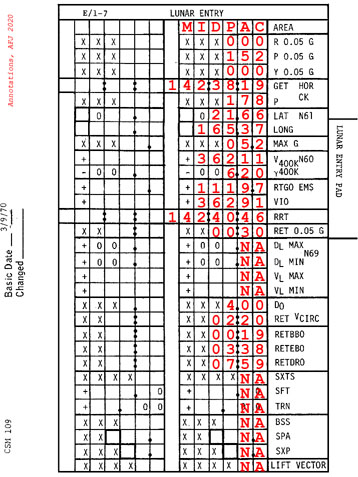
The refined entry PAD. The shallowing of their trajectory is shown by the smaller angle, gamma, between their flight path and the horizontal at Entry Interface. Also, their expected peak deceleration is down from 6.7g to 5.2g.
141:51:12 Kerwin: No, actually, we didn't.
This is Apollo Control, Houston; now 141 hours, 53 minutes now into the flight. Our final PAD shows a time of Entry Interface at 142 hours, 40 minutes, 46 seconds; begin blackout at plus 19 seconds from time of Entry Interface, end the blackout, 3 minutes and 38 seconds. Time of drogue deploy from Entry Interface is plus 7 minutes and 59 seconds; main chute deployment plus 8 minutes, 46 seconds from time of Entry Interface. And predicted time of splash; 13 minutes, 44 seconds from time of Entry Interface. We're now at 141 hours, 54 minutes into the mission, continuing to monitor; this is Apollo Control, Houston.
Apollo Control, Houston at 141 hours, 55 minutes into the flight of Apollo 13. At the present, we're now feeding a downrange picture of the recovery on the closed circuit television circuit. Further report from recovery: all recovery aircraft, the C-130s, are airborne and helicopters 1 and 2 with swimmers are airborne and proceeding to station at this time. This is Apollo Control, Houston; at 141 hours, 56 minutes into the flight of Apollo 13.
Apollo Control, Houston; 141 hours, 56 minutes into the flight. Apollo 13 now 7,084 nautical miles away from Earth, velocity increasing. They are presently reading 20,770 feet per second. For the report from recovery, both ARIA aircraft are airborne and on station. This is Apollo Control, Houston at 141 hours 57 minutes into the flight.
Apollo Control, Houston; 141 hours, 59 minutes - correction - 142 hours now into the flight. We show Apollo 13 at an altitude of 6,613 nautical miles away. Velocity really beginning to build up now, now reading 21,227 feet per second. We show 40 minutes from time of reentry into the Earth's atmosphere.
142:00:42 Kerwin: Odyssey, Houston. Over.
142:00:44 Swigert: Go ahead.
142:00:45 Kerwin: Okay, Jack. We'd like P00 and Accept for your final state vector. [Pause.]
142:00:55 Lovell: You've got it. [Pause.]
142:01:04 Kerwin: And, Odyssey, Houston. We're also sending you a final PIPA bias update and clock increment. Over.
142:01:12 Lovell: Okay. Fine; thank you, Joe. How does the LM look? Are you still tracking it?
142:01:17 Kerwin: All I've heard was that it's - that the cabin was holding pressure. I haven't heard anything more. And, Odyssey, we're ready for you to warm up the BMAG number 2's at your discretion and we're curious whether the Moon check attitude is good. Over.
142:01:43 Swigert: Yes, Joe, it's coming down. I got just about 45 degrees now and it's coming on down.
142:01:50 Kerwin: Roger that.
This is Apollo Control, Houston; 142 hours, 3 minutes now into the flight. We presently show on one of our displays a splash coordinates of 21 degrees, 39 minutes South; 165 degrees, 23 minutes West. Apollo 13 now at an altitude of 5,862 nautical miles. Velocity now reading 22,085 feet per second.
142:06:12 Kerwin: Odyssey, Houston. The computer is yours. Over.
142:06:15 Swigert: Okay. Thanks, Joe. [Long pause.]
Apollo Control, Houston; 142 hours, 7 minutes now into the flight of Apollo 13. Odyssey now 34 minutes away from time of entry into the Earth's atmosphere. Mission Control has just passed a computer update to the onboard CMC and as you heard Joe Kerwin's last report to the crew, telling them that the computer now belongs to them. We're at 142 hours, 7 minutes; continuing to monitor, this is Apollo Control.
142:07:06 Swigert: Okay, Joe. The Moon is coming down to about 38 degrees.
142:07:10 Kerwin: Okay, Jack. Sounds real good.
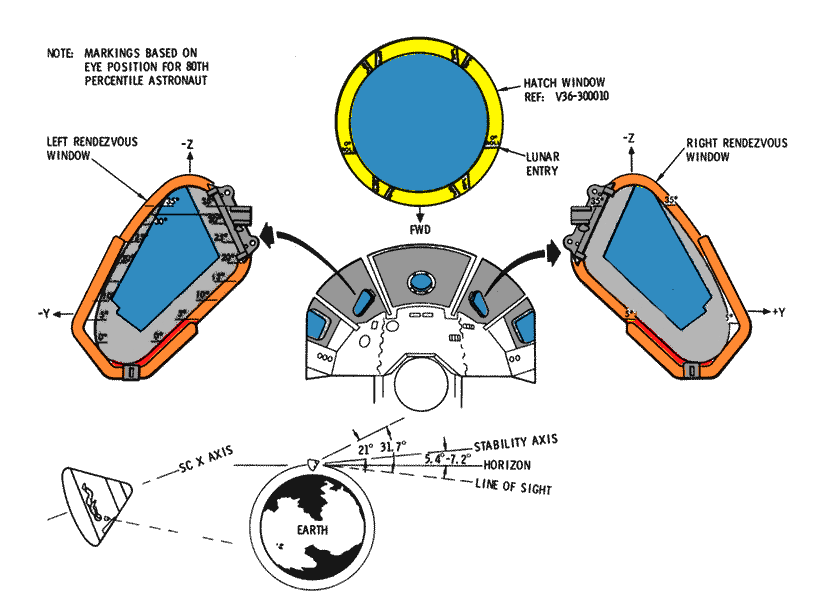
Observation of the Moon on their hatch window has been successful.
Apollo Control at 142 hours, 8 minutes now into the flight of Apollo 13. Presently 5,134 nautical miles away from Earth. Velocity now reading 23,023 feet per second. We're 33 minutes away from time of entry. This is Apollo Control, Houston.
142:09:00 Kerwin: Odyssey, Houston.
142:09:02 Lovell: Go ahead.
142:09:03 Kerwin: Okay. We'd like the S-Band Power Amplifier to Off, center, at this time, Jim.
142:09:11 Lovell: Off, center, is done
142:09:14 Kerwin: Okay. You're still looking real fat on power. We show you having over 30 amps on the water. If you do get into a bind and don't come up - that's amp-hours - don't come up with Recovery, you can always power down and you can always put the pyro batteries on the line if you need them after you're down.
This is Apollo Control, Houston; 142 hours, 14 minutes now into the mission. Apollo 13 presently 4,075 nautical miles out from Earth. Velocity now showing 24,619 feet per second. We're less than 27 minutes now from time of entry into the Earth's atmosphere.
142:17:54 Swigert: Joe, are you planning to run this all the way down without the suit compressor?
142:18:00 Kerwin: Say again, Jack.
142:18:02 Swigert: Are you planning to turn on the suit compressor at all on the way down?
142:18:07 Kerwin: That's negative Jack; I'll verify it; but I sure don't think so.
142:18:11 Swigert: Okay, that's all right with us. [Pause.]
142:18:22 Kerwin: Okay, Jack, this is Houston, we have power, and you can cycle it for 10 minutes if you so desire, but we don't think you need to do it. Over.
142:18:31 Swigert: Okay, we'll hold that.
142:18:33 Kerwin: Okay, real fine. How did the EMS check go, Jack?
142:18:36 Swigert: EMS checked out okay...
142:18:39 Kerwin: Good deal.
142:18:40 Swigert: Its been initialized and setting on Entry.
Apollo Control, Houston; 142 hours, 17 minutes now into the mission. Our digital display at present shows Apollo 13 at 3,505 nautical miles away from Earth, now traveling at a speed of 25,693 feet per second. Jack Swigert confirms that the EMS check went well, which provides a good backup monitor for checking the guidance and navigation system performance. We are at 142 hours, 18 minutes into the flight; and this is Apollo Control, Houston.
142:20:21 Swigert: Okay, Joe, are you watching - you and FIDO taking a look at our Noun 60 here?
142:20:26 Kerwin: That's affirmative; hold it just a second; we are looking at 6.13 and 4.80; I'll get a check on that.
142:20:37 Swigert: Hey that's not too many g's.
142:20:41 Kerwin: Jack, FIDO says that okay.
142:20:45 Swigert: Okay. [Long pause.]
Apollo Control - that was a reading from the onboard computer displays showing a velocity at entry of 36,211 feet per second [11,037 m/s].
142:21:21 Kerwin: Jack, Houston, your Noun 63 looks good to us also.
142:21:25 Swigert: Okay. [Long pause.]
Apollo Control, Houston; at 142 hours, 22 minutes into the mission.
142:22:08 Swigert: Joe, how far out do you show us now?
142:22:12 Kerwin: Oh, on our plot board up here, we can't hardly see how far out you are.
142:22:19 Swigert: Okay. [Pause.]
142:22:28 Swigert: I know all of us here want to thank all you guys down there for the very fine job you did.
142:22:36 Lovell: That's affirm, Joe.
142:22:38 Kerwin: I'll tell you - We all had a good time doing it. [Long pause.]
We now now show Apollo 13 at a distance at 2,581 nautical mile [4,780 km].
142:22:56 Kerwin: Okay, Odyssey; Houston. Just for your information, it looks as though battery C will deplete around main chute time; that's expected; you've got plenty of amp-hours in the other batteries.
We now show velocity of 27,553 feet per second at 142 hours, 24 minutes.
142:24:34 Kerwin: Odyssey, Houston. Over. [Pause.]
142:24:45 Kerwin: Odyssey, Houston. Over. [Long pause.]
142:25:04 Kerwin: Odyssey, Houston. Over. [Pause.]
Apollo Control, Houston at 142 hours, 25 minutes now into the mission - aboard Apollo 13...
142:25:13 Kerwin: Odyssey, Houston. Over.
142:25:16 Swigert: Go ahead. [Pause.]
142:25:25 Kerwin: Okay, I was just going to tell you about that handover we just had, but I was a little late on the - on the ball. Since we're fat on power and we'd kind of like to have S-band with you after blackout - we'd - We'd like you to delete the step on your entry checklist page 2-5, after "Begin blackout," it says "Power PMP to Off." We'd like you to leave it on if you think of it. Over.
We're now reading the onboard computer display, which shows a present velocity of 29,160 feet per second. This is what the crew is reading out. A range-to-go distance of 4,984 nautical miles [9,230 km]. We're at 142 hours, 26 minutes into the flight. We show 14½ minutes from time of Entry Interface.
Thirteen minutes now from predicted time of entry. The onboard computer shows a velocity of 30,113 feet per second [9,178 m/s], range-to-go distance 4,683 nautical miles [8,673 km]. Retrofire Officer has just reported to Flight Director Gene Kranz, we look real good here now. TELMU has just reported to Flight Director Gene Kranz that we have now lost tracking on Lunar Module Aquarius.
Eleven minutes away now from time of Entry Interface. Onboard displays show a velocity of 31,141 feet per second [9,492 m/s], range-to-go distance of 4,332 nautical miles [8,023 km]. We're at 142 hours, 30 minutes into the flight of Apollo 13.
142:30:47 Kerwin: Odyssey, Houston. Over.
142:30:49 Swigert: Go ahead.
142:30:50 Kerwin: Okay. At 10 minutes to 400 K, you're looking good; we're real happy with the trajectory, and a minute ago, we just lost contact with your friend Aquarius.
142:31:03 Swigert: Okay. Where did she go?
142:31:07 Kerwin: Oh, I don't know. She's up there somewhere.
142:31:13 Swigert: She sure was a good ship.
142:31:16 Kerwin: Hey, just as I said that, we got another burst of LM data, so I guess it's still ticking.
Nine minutes now from time of Entry Interface. The onboard computer now reading a velocity of 32,193 feet per second [9,812 m/s]. A range-to-go distance of 3,919 nautical miles [7,258 km].
142:33:06 Kerwin: Odyssey, Houston. Your DSKY is doing all the right things. The G&N is GO. Over.
142:33:11 Swigert: Okay. Thank you. [Pause.]
142:33:18 Swigert: You have a good bedside manner, Joe.
142:33:22 Kerwin: Say again, Jack.
142:33:25 Swigert: You have a good bedside manner.
142:33:31 Kerwin: (Laughter) That's the nicest thing anybody's ever said! How about that? [Pause.]
Capcom Joe Kerwin, in addition to being an astronaut, is also a medical doctor.
142:33:43 Swigert: Sure wish I could go to the FIDO party tonight.
142:33:47 Kerwin: (Laughter) Yes, it's going to be a wild one. [Long pause.]
Less then 7 minutes now from entry into the Earth's atmosphere. Onboard display now shows a velocity of 33,383 feet per second [10,175 m/s].
142:34:04 Kerwin: Somebody said, 'We'll - We'll cover for you guys; and, if Jack's got any phone numbers he wants us to call, why, pass them down.'
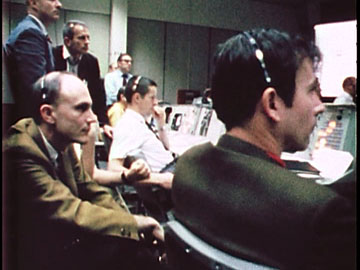
Astronauts have gathered around the CapCom station. Ken Mattingly, John Young, Tom Stafford, Deke Slayton and CapCom Joe Kerwin. NASA 16mm film capture. NASA/NARA.
Range to go now 3,271 nautical miles [6,058 km]. We're 6 minutes now from time of reentry into the Earth's atmosphere.
Five minutes to go now for reentry into the Earths atmosphere. Now reading a velocity of 34,335 feet per second [10,465 m/s]. Range to go 2,921 nautical miles [5,410 km]. Flight Director Gene Kranz now going around the room posting his Flight Control team as to the status.
142:36:15 Kerwin: Odyssey, Houston. Over.
142:36:17 Swigert: Go ahead.
142:36:18 Kerwin: Okay; We just had one last time around the room and everybody says you're looking great.
142:36:24 Swigert: Thank you.
4 minutes to go now for Entry Interface, velocity now reading now 34,802 feet per second [10,608 m/s], range to go about 2,625 nautical miles [4,862 km].
Still receiving onboard data. Still looking good. Three minutes to go now from the time of entry into the Earth's atmosphere. Onboard display shows a velocity of 35,245 feet per second [10,743 m/s]. Range to go, 2,301 nautical miles [4,261 km].
142:38:14 Swigert: The mood fits the color.
142:38:33 Kerwin: Odyssey, Houston. Over.
142:38:35 Swigert: Go ahead.
142:38:36 Kerwin: Okay LOS is about a minute or a minute and a half; in entry attitude, we'd like Omni Charlie, and welcome home. Over.
142:38:45 Swigert: Thank you.
Two minutes to go till entry. Velocity now reading 35,646 feet per second [10,865 m/s]. Range to go, 1,961 nautical miles [3,632 km].
Apollo Control, Houston. We've just had Loss Of Signal from Honeysuckle with Apollo 13. Our last velocity reading was 35,837 feet per second [10,923 m/s] with a range to go of 1,791 nautical miles [3,317 km].
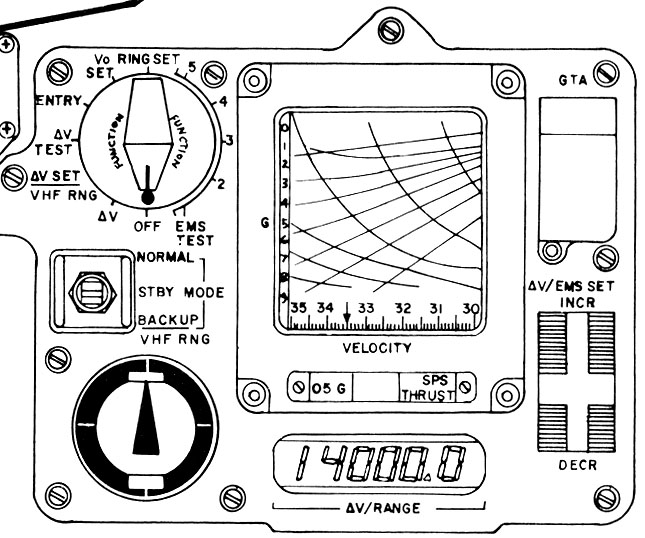
The Entry Monitoring System at the Main Display Console. Scan via heroicrelics.org
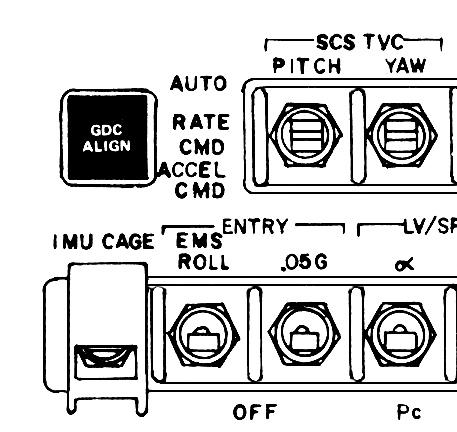
The switches for manually starting the EMS. Scan via heroicrelics.org
Apollo 13 should have entered the Earth's atmosphere at this time. A few moments ago, we had a report from the Retrofire Officer that based on his data, a predicted set of coordinates for splash of 21 degrees, 39 minutes south of 165 degrees, 22 minutes west. The period of blackout for the spacecraft should have begun about 20-some odd seconds ago.
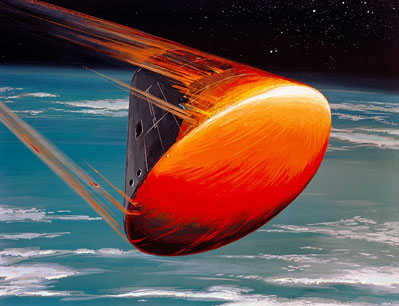
An artist's imagined view of the Command Module entering Earth atmosphere.
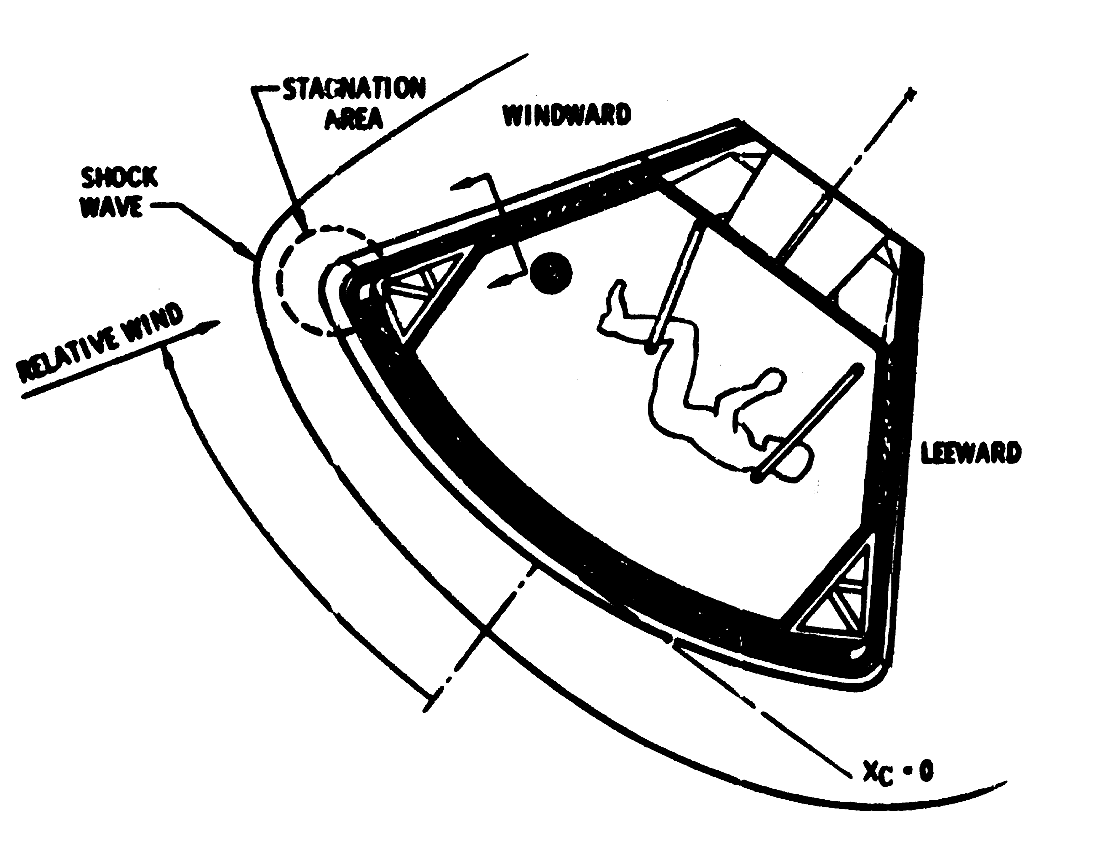
The Entry Shockwave and drag to lift ratio.
Apollo Control, Houston. Apollo 13 should be coming up on max g right now. Our last estimate for max g was 5.2 g's.
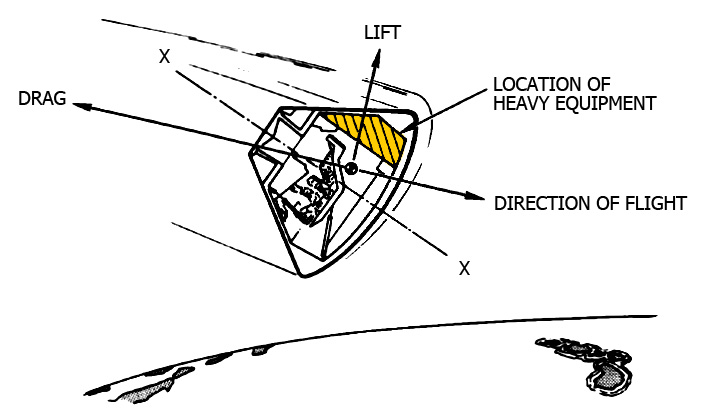
Command Module Reentry Aerodynamics
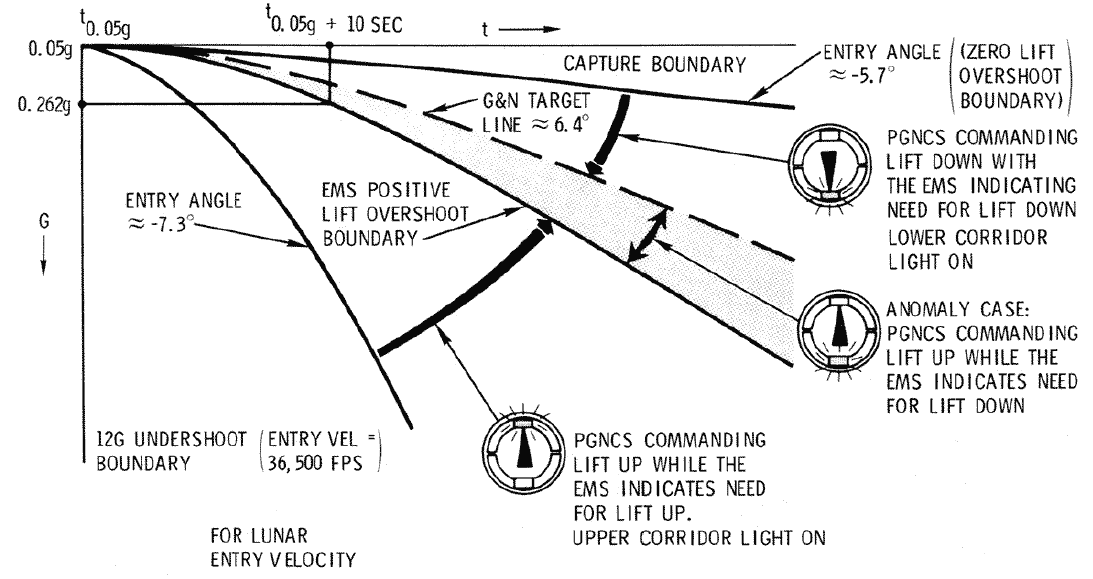
Various entry corridor states and the associated EMS displays.

Entry Monitoring System Scroll pattern
We have about a minute and a half to go during this period of blackout. Here in Mission Control, the scene from the recovery ship Iwo Jima has been flashed up on one or our large screens for all our flight controllers to watch. We have about 1 minute to go now to time of end of blackout.
About 30 seconds to go for blackout.
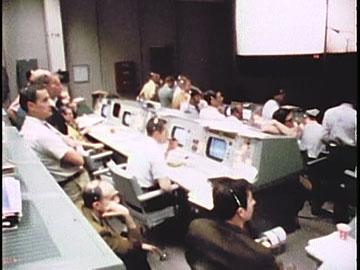
Astronauts await the splashdown. NASA 16 mm film capture. Via NARA.
Less than 10 seconds now. We will attempt to contact Apollo 13 through one of the ARIA aircraft. Continuing to monitor, this is Apollo Control, Houston.
Apollo 13 should be out of blackout at this time. We are standing by for any reports of ARIA acquisition, ARIA a C-135 type aircraft.
Coming up now on 3 minutes until time of drogue deployment, standing by for any reports of acquisition.
We're had a report that ARIA 4 aircraft has Acquisition Of Signal.
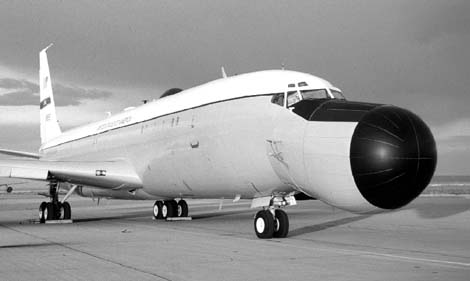
ARIA aircraft, with an S-band antenna system on the oversized nosecone.
142:46:03 Kerwin: Odyssey, Houston standing by. Over.
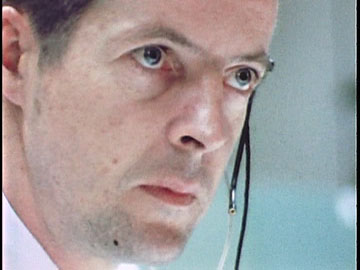
A tense Joe Kerwin awaits radio contact, or a visual on the CM.
142:46:08 Swigert: Okay, Joe.
142:46:12 Kerwin: Okay. We read you, Jack. [Long pause.]
That was Jim Lovell responding with the 'Okay, Joe.' Correction there. That was Command Module pilot Jack Swigert.
142:46:28 Kerwin: We're looking at the weather on TV and it looks just as advertised; real good.
Less than 2 minutes now from time of drogue deployment.
Less than a minutes away now from time of drogue deployment.
Less than 30 seconds away now from drogue deployment. The drogue deployment - these 2 chutes will provide braking and stabilization prior to main chute deployment. Standing by now for - continue to monitor.
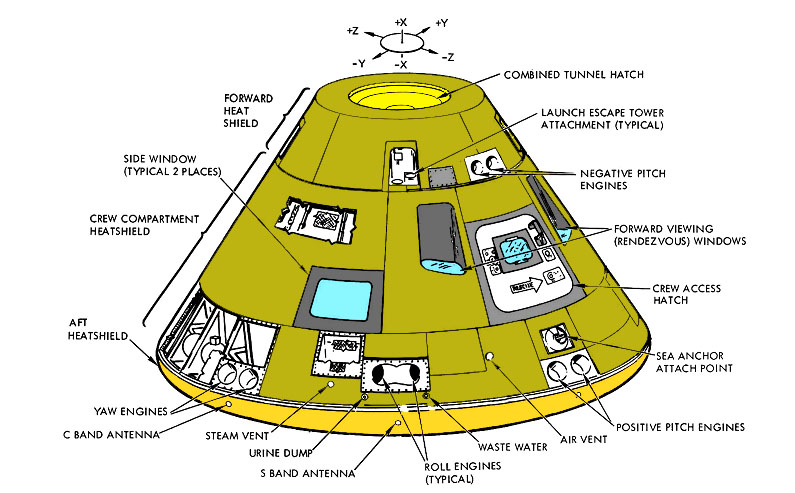
Exterior view of the Command Module.
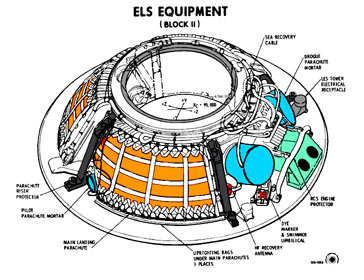
Earth Landing System equipment, under the apex cover.
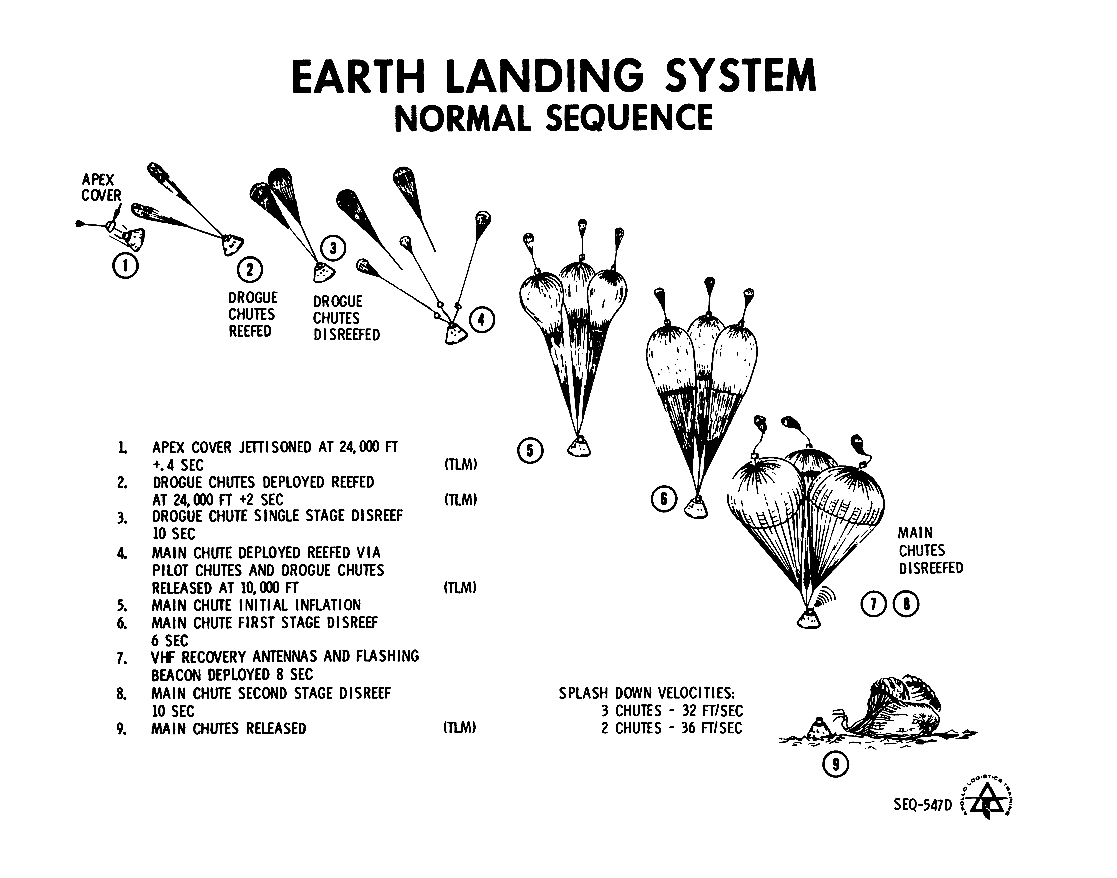
Normal landing sequence.
142:48:53 Kerwin: Odyssey, Houston standing by for your Noun 67 when you get it. Over. [Long pause.]
142:49:17 Swigert: We got two good drogues.
142:49:20 Kerwin: Roger that.
142:49:21 Swigert: [Garble] thousand. [Long pause.]
A report of 2 good drogues. Coming up now for main chutes.
Standing by for confirmation of main chutes.
142:50:06 Kerwin: Odyssey, Houston. We show you on the mains, it really looks great. [Pause.]
An extremely loud applause here in Mission Control.
142:50:15 Kerwin: Got you on television, babe.
142:50:17 Swigert: [Garble]. [Pause.]
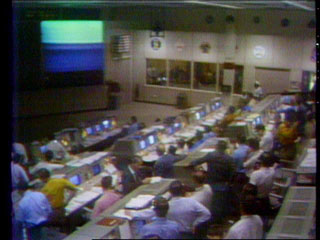
Mission Control erupts in joy.
An extremely loud applause as Apollo 13 on main chutes comes through loud and clear on the television display here.
142:50:26 Swimmer 2: Iwo Jima Control, this is Swim 2. I have a visual bearing 182. [Pause.]
142:50:34 USS Iwo Jima: Iwo Jima; Roger.
142:50:39 Recovery helicopters: Iwo Jima Control, this is [garble] Recovery. I have a visual bearing 190. Over.
142:50:44 USS Iwo Jima: Iwo Jima; Roger. [Pause.]
142:50:52 Swimmer 1: Iwo Jima, Swim I has a visual at 110. [Garble].
142:50:57 USS Iwo Jima: Iwo Jima; Roger.
142:50:59 Recovery helicopters: Apollo 13, Apollo 13, this is Recovery. Over. [Long pause.]
A recovery helicopter has just put in a call to Apollo 13.
142:51:18 Recovery helicopters: Apollo 13, Apollo 13, this is Recovery. Over. [Long pause.]
We have a report from the Iwo Jima that Apollo 13 at a distance of 4 miles from the ship.
142:51:47 Recovery helicopters: Apollo 13...
142:51:49 Swigert: Go ahead.
The smoke you see is venting of RCS propellants, a Reaction Control System propellants.
142:51:55 Swigert: ...see you loud and clear going through 5,000.
142:51:59 Recovery helicopters: Roger, Apollo 13. This is Recovery and your chutes look good. [Pause.]
142:52:11 Recovery helicopters: Apollo 13, this is Recovery. We observed your RCS burn. Over.
You heard the conversation between the recovery helicopter and the crew of Apollo 13. The floor of the Mission Operations Control Room now crowded and there are visible smiles on the faces of the flight controllers and astronauts in this room.
142:53:38 Recovery helicopters: This is Recovery. Apollo 13 is descending through 2000 feet.
142:53:42 USS Iwo Jima: Okay. Our altimeter concurs.
142:53:47 USS Iwo Jima: Iwo Jima; Roger. Out. [Long pause.]
A report from the Iwo Jima that Apollo 13 is descending at a point 4 miles due south of the ship.
142:54:09 Recovery helicopters: Apollo 13 and Recovery passing through 1,000 feet.
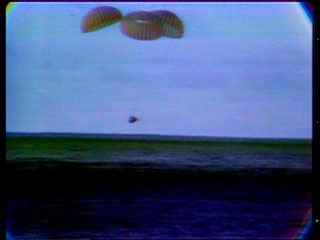
The Command Module nearing splashdown.
142:54:14 USS Iwo Jima: Iwo Jima; Roger. [Long pause.]
142:54:34 Recovery helicopters: Through 500 feet.
142:54:38 Swimmer 1: Swim 1 on station.
142:54:40 Swimmer 2: ...2 is on station.
142:54:44 Photographic helicopters: Photo 1's on station. Photo 1 observes splashdown at this time.
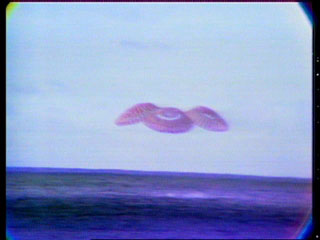
The splashdown viewed on the TV from the recovery helicopter.
142:54:48 USS Iwo Jima: 1 [garble] pickup [garble].
142:54:49 Swimmer 1: Roger. [Pause.]
Another cheer in the control room as we had splashdown.
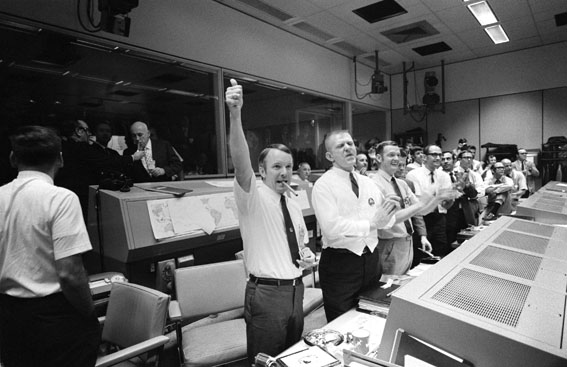
Jubilant Flight Controllers in Mission Control.
142:54:56 Photographic helicopters: Photo-1. Splashdown at this time. The three chutes are displaced. They're in the water. [Long pause.]
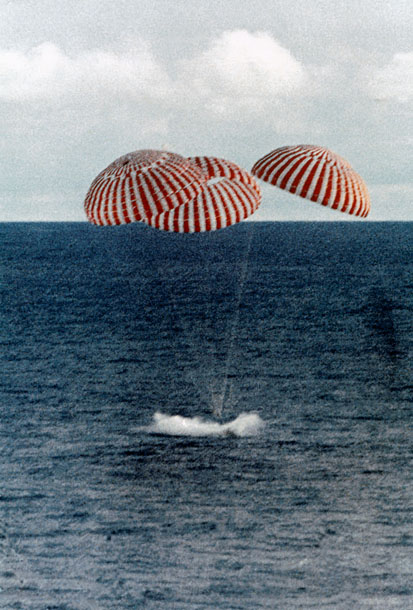
The moment of splashdown of Apollo 13's Command Module.
142:55:12 Recovery: Helicopters: [Garble] Recovery, I have a clock...
142:55:15 Recovery 1: [Garble] 3½ miles Iwo Jima.
142:55:24 Speaker: Iwo Jima, Roger.
142:55:26 Recovery 1:This 401 the Command Module is stable 1 at this time. They are riding comfortably. [Long pause.]
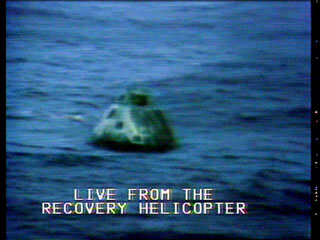
The Command Module in the water, moments after splashdown. TV capture.
142:55:43 Recovery: Recovery [garble] main chutes. [Long pause.]
The spacecraft splashed in Stable 1. That's with the apex cover up, out of the water.
142:56:12 Recovery 1: The vertical axis are approximately 15 degrees. [Long pause.]
142:56:32 Recovery: Recovery is maneuvering to grab hold of the main chute the 2 other chutes are still visible in the water. Swim 1, you are clear to move up to position to retrieve the other chutes.
142:56:39 Swimmer 1: Swim 1. Roger.
142:56:50 Photographic helicopters: This is photo 1, I observe the flashing light on top of the Command Module. [Pause.]
142:57:03 Recovery: 1 on 270. [Pause.]
142:57:16 Recovery: Warm present [garble] Winds in the area from 270 magnetic to approximately 6 knots. [Long pause.]
Recovery 1 will be the - will perform the pickup of the crew.
142:57:39 Recovery: Recovery beacon antenna atop the command Module. [Long pause.]
142:58:00 Recovery: This is photo 1. The Mylar covering above the exterior of the Command Module has been removed in the area opposite the crew exit hatch. [Pause.]
142:58:16 ARIA: ARIA, our recovery has been one of the main chutes [garble] has deployed a raft, just opened. [Garble]. [Garble]. [Pause.]
142:58:38 Recovery 1: [Garble] in the Command Module there's swells 3 to 5 feet from the vehicle. Sea is approximately 1 to 2 feet. [Pause.]
142:58:58 Iwo Jima: Photo, this is Iwo Jima. Interrogative astronaut condition ordered.
142:59:03 Recovery: 41, Roger. Brings Apollo 13 a crew condition, okay. Over.
142:59:10 Recovery 1: [Garble].
142:59:14 Recovery 1: Roger. Copy, Iwo Jima.
142:59:17 Iwo Jima: Iwo Jima, copy. [Pause.]
142:59:25 Iwo Jima: This is for a [garble] conditions in a recovery area, approximately 6/10, cloud cover, combination high cirrus and low stratos. [Pause.]
142:59:41 Recovery 4: Iwo Jima, this is recovery. I am assuming Odyssey commander just fine, unless otherwise directed commence a retrieval operation in one minute. Over.
142:59:54 Iwo Jima: This is Iwo Jima, Roger.
142:59:58 Recovery 1: Continue retrieval of that magnitude 12 to 2. You're clear, got you ready for mission. Recovery is taking backup for the gentlemen. [Pause.]
143:00:19 Recovery 1: This is photo 1 presently unable to see the third main chute. But Swim 1 is grappling the second main chute. [Pause.]
143:00:34 Speaker: [Garble].
143:00:41 Kerwin: Okay, Jack you got 13's drift.
143:00:44 Recovery: The Command Module is very slight at this time in the direction of and a 1 to 10 magnetic. [Long pause.]
143:01:22 Recovery: Presently Swim 1 is still attempting to make connection with the second main chute. [Long pause.]
143:01:42 Recovery: Swim 4 unable to grab it at [garble] before we could graple.
143:01:48 Recovery: This is recovery, Roger, understand.
143:01:51 Swim 1: Swim 1 stand by for a hit.
143:01:55 Swim 1: Swim 1, Over. [Garble], Over.
143:02:07 Swim 1: Roger, swim 1 should [garble] so speeds to the apex cover and the [garble].
143:02:18 Recovery: Swim 2, this is Recovery. You're clear to deploy a swimmer at sea anchor.
143:02:24 Swim 2: Roger. [Long pause.]
143:02:46 Recovery 1: This is photo 1, observe the uprighting bags are partially inflated at this time. [Long pause.]
We copied the report and see it visually; the uprighting bags inflated.
143:03:07 Photo 1: This is Photo 1 estimates uprighting bags are approximately ⅓ inflated. I can see partial inflation on all 3 uprighting bags. [Pause.]
143:03:26 Recovery 1: Apollo 13, This is Recovery.
143:03:28 Lovell: Go ahead.
143:03:30 Recovery 1: Roger 13, this is Recovery will you confirm a successful RCS dump; over.
143:03:36 Lovell: That's affirmative; we had a successful dump.
143:03:39 Recovery 1: We [garble].
143:03:49 Photo 1: This is Photo 1; the first swimmer has been deployed. The signals are thumbs up in the water; in good condition. [Pause.]
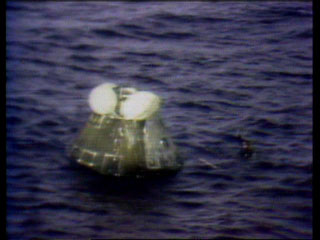
All clear so far!
143:04:03 Photo 1: He is making his way to the Command Module. [Pause.]
143:04:14 Photo 1: Inflation of the uprighting bags estimated to be 40 percent. 40 percent.
143:04:28 Photo 1: The first swimmer is at the Command Module. They will commence to anchor an attachment shortly.
143:04:38 Recovery 1: Apollo 13, this is Recovery; over.
143:04:45 Lovell: Go ahead Recovery; 13 here.
143:04:48 Recovery: Roger; this Recovery; do you have lap to go on [garble] formula?
143:04:56 Swigert: No sir; we closed the display, and were helping Houston copy it; we didn't let it out over the air.
143:05:03 Recovery: [Garble] Roger out.
143:05:07 Swigert: Will you give us our distance to the ship?
143:05:09 Recovery: It appears from Recovery your present distance from the ship 1 mile - 3002; you're splash down point 3 - 3 miles from the Iwo Jima.
143:05:24 Swigert: Thank you.
143:05:28 Photo: This is Photo 1; the sea anchor has been attached, and have done [garble] observed a thumbs up from the swimmers.
143:05:35 Recovery: Swim 2, This is Recovery. You are clear to deploy two swimmers and the flotation collar; over.
143:05:43 Photo: Roger, Roger. [Pause.]
The sea anchor attached to a pad eye on the side of the Apollo 13 Command Module.
143:05:52 Recovery: We're getting thumbs up. Everything progressing satisfactorily.
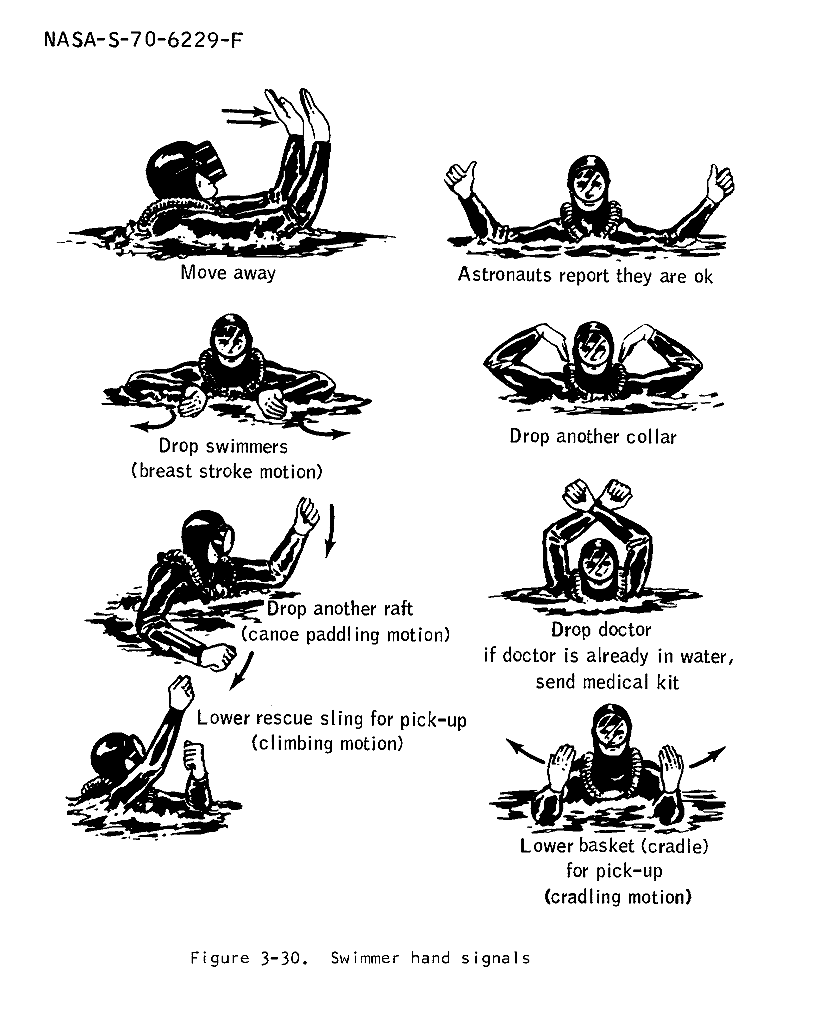
Apollo rescue swimmer hand signals.
This done to slow down the drift.
143:06:01 Recovery: Has oriented the Command Module in the customary manner.
143:06:25 Recovery: Swim 2 is moving in; to deploy the flotation collar and two additional swimmers. Swim 1 has deployed a smoke in the area, and is attempting to restrain the accessories. [Pause.]
143:06:49 Recovery: Swim 1 has deployed a swimmer in the water. Swim 2 has deployed 2 swimmers. I see a thumbs up, and the flotation collar is deployed.
143:07:05 Recovery: The uprighting bags are inflated approximately 90 percent at this time. The swimmers are working the flotation collar in, to the Command Module.
143:07:40 Recovery: The flotation collar is at the Command Module; the front seat is being extracted, and it is being pulled around the Command Module. [Long pause.]
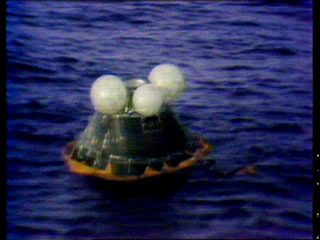
The still deflated flotation collar being attached to the Command Module. TV capture.
The flotation collar will be pulled around the Command Module with a bungee cord.
143:08:15 Recovery: One section of the bungee is being attached to the sea anchor attachment ring; it appears to be satisfactorily connected; the second section of the bungee is approximately 90 percent around the Command Module. [Pause.]
The flotation collar will be hooked to a bungee line, by a line with rings on the flotation collar, and will be pulled around before it is inflated.
143:08:12 Recovery: Inflation collar has commenced. It is approximately 20 percent around the Command Module. [Pause.]
143:08:12 Recovery: The flotation collar is approximately 60 percent deployed around the Command Module [Pause.]
143:09:18 Recovery 1: There is no apparent drift of the Command Module at this time. [Long pause.]
And after the collar is secured the two 7-man life rafts will be dropped with sea anchors attached to the bottom. This is done to keep the rafts from turning over from helicopter backwash.
143:09:43 Recovery 1: Inflation collar's progressing normally.
143:09:50 Recovery 1: [garble] completed around the Command Module.
143:09:56 Recovery 1: We are standing by for inflation. [Long pause.]
143:10:34 Kerwin: [garble] to Iwo Jima. Request your pass to Apollo. Turn off recovery beacon. Over.
143:10:40 Recovery 1: Roger, Break Apollo 13 do you copy?
143:10:43 Lovell: Roger, [garble] will turn off.
143:10:44 Kerwin: Roger. [Pause.]
143:10:52 Recovery: Inflation of the flotation collar presently normal. Standing by for inflation. Our [garble] flotation taking place at this time. Recovery is 60 percent complete. Flotation of - inflation of the flotation collar appears complete at this time. [Long pause.]
143:11:40 Recovery: Apollo 13 appears to be riding a little more comfortably at this time. The axis is negligible. [Long pause.]
143:11:59 Recovery: The swimmer is installing securing straps. This has [garble] to the power bolt on the upper deck. Efforts are made and he gives the signal for deployment of the egress raft.
143:12:16 Recovery 1: [Garble] this is recovery. You are clear to deploy the egress raft [garble] backup position. Recovery goes to ready position.
143:12:26 Unknown Speaker: Ready, Roger.
143:12:28 Recovery: [Garble]. One further adjustment is being made for the securing straps.
143:12:35 Unknown Speaker: Situation is normal. [Long pause.]
143:13:14 Recovery: Swimmer 2 has commenced his maneuvering for deploy of the egress raft.
143:13:32 Recovery: Swimmer 2 is in position. The crewmen are standing by at the hatch. The egress raft is in the water now approximately 10 feet from the Command Module. [Pause.]
143:13:50 Recovery: Two swimmers have the raft [garble] and are swimming it to the Command Module.
143:14:15 Recovery: The raft is at the Command Module. The swimmers are opening it.
The next step in our sequence is to open the hatch.
143:14:25 Recovery: Inflation has begun of the egress raft. [Pause.]
143:14:39 Recovery: The inflation appears to be satisfactory. [Long pause.]
143:14:55 Recovery: The swimmers are working to secure the egress raft to the flotation collar. [Long pause.]
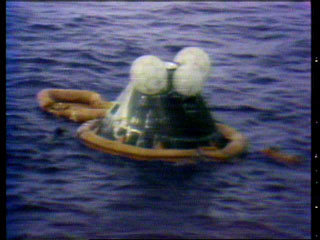
Swimmers are about to attach the newly inflated raft to the flotation collar in front of the hatch.
143:15:12 Recovery: We presently have three swimmers in the water and I observe the signal, assembly here.
143:15:21 Recovery: The Recovery is making approach to the deploy from the [garble]. [Long pause.]
143:15:42 Recovery: Swim leader is in the water, comes up. Good condition. Stand by. [Pause.]
143:15:57 Recovery: Swim leader approaching the Command Module. At this time, the inflation of the platform of the egress raft has been completed and is satisfactory. [Long pause.]
143:16:27 Recovery: The situation static at this time presently has two swimmers in the egress raft, and two swimmers standing by in the water. The swim leader is standing on the flotation collar checking the interior of the Command Module.
143:16:47 Unknown speaker: [Garble] go ahead for [garble]. [Long pause.]
143:17:07 Recovery: A swim leader is standing on the flotation collar appearing in the forward viewing windows. [Long pause.]
143:17:37 Recovery: Recovery is trying to approach to deploy the astronaut's flotation equipment. [Long pause.]
143:17:54 Recovery: Recovery is moving into position; the rescue net is halfway down.
143:18:23 Recovery: Recovery is maneuvering to place the rescue net in the egress raft. A swim leader, has the rescue net in hand and it is in the egress raft. The equipment is being removed [garble]. Now the rescue net is on its way back. [Long pause.]
143:19:14 Recovery: The swim leader is at the crew access hatch. He appears to be getting ready to open the access hatch. He is checking into the forward viewing window. [Pause.]
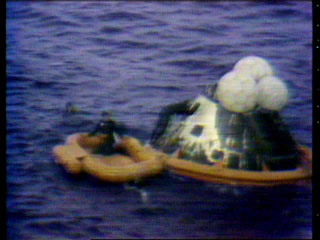
The egress raft is ready and the diver is looking into the Command Module
143:19:33 Tracking Ship: Roger sir. Iwo Jima repeat one more time on item Papa [garble] minus 113 USB.
143:19:47 Tracking Ship: Over. [Pause.]
143:19:56 Tracking Ship: Roger. Copy. Minus 113 dBm signal strength.
143:20:02 Relay: Photo 1. The crew hatch is open. The equipment is being passed to the astronauts. The hatch is closed again. [Garble].
143:20:15 Tracking Ship: Roger. Copy all.
143:20:25 Relay: Situation static at this time. The two swimmers are standing by in safety position in two the water. The two swimmers have the egress raft.
143:20:34 Tracking Ship: Roger, sir. We copy and their picking it up [garble].
The three Apollo 13 crewmembers will be hoisted up into the Recovery 1 helicopter by the Billy Pugh net, the device you see that looks much like a half birdcage. For the first time, there are stiffeners in this net, the Billy Pugh net has been used on previous recoveries. These made out of aluminum to provide rigidity to the net. The three Apollo crewmembers will exit the spacecraft into the egress raft. The Billy Pugh net, by the way, has a center of gravity, which is forward of the center line toward the open end to assure that...
143:21:55 Relay: The situation is nominal at this time. Standing by while the astronauts make their preparations inside the Command Module. [Pause.]
143:22:10 Unknown: ARIA, to MC ARIA Control. [Long pause.]
This forward center of gravity is designed to assure that an individual being picked up would not tumble out.
143:22:24 Relay: The swim leader is opening the crew access hatch. It is completely open.
143:22:32 Unknown: Roger [garble] okay.
143:22:41 Relay: The first astronaut is climbing out of the Command Module, and is in the egress raft.
143:22:49 Unknown: ARIA to ARIA control [garble].
143:22:54 Relay: The second is now on his way out, assisted by swin leaders.
143:23:01 Iwo Jima: And you want that on all. The third astronaut's on the Iwo Jima raft, third astronaut is standing on flotation collar egress raft [garble].
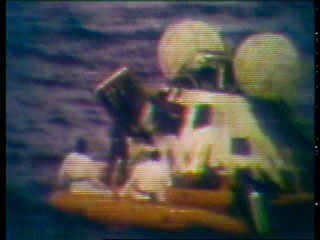
TV capture shows the crewmen being helped out of the Command Module by rescue swimmers.
143:23:45 Relay: Swim leader is making his final check prior to closing the access hatch. The hatch is closed. He is securing it with the hatch [garble]. [Long pause.]
143:24:16 Relay: We have three swimmers in the safety position in the water. Swim leader is giving the signal for the rescue net. [Long pause.]
143:24:35 Relay: Recovery is manuevering for position to commence receive the astronauts. [Pause.]
143:24:52 Relay: The rescue net is half way down. [Long pause.]
143:25:06 Unknown: One, two, three, four, five, one, two, three, two, one. One, two, three, four, five.
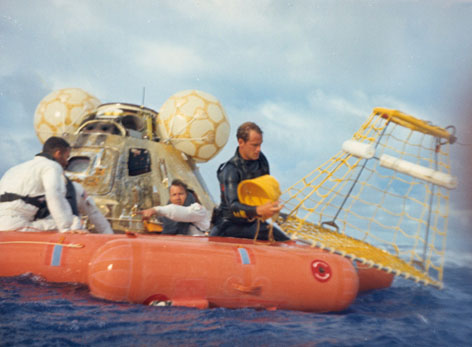
The rescue net is received at the egress raft. The Apollo crewmen are ready to go up.
143:25:16 Relay: The rescue net is in hand resting on the platform. The first astronaut is climbing aboard, the signal is given, ready for lift.
143:25:32 Relay: The first astronaut is on his way up, next one [garble] wait. [Pause.]
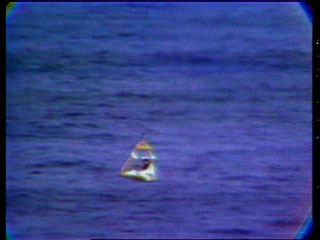
Fred Haise being hoisted up.
143:25:44 Relay: The first astronaut is half way up. [Long pause.]
143:25:59 Relay: The first astronaut is at the cargo hatch and is safely aboard the helicopter. [Long pause.]
143:26:22 Helicopter 1: Recovery I have astronaut Haise aboard and his condition is excellent.
143:26:28 Iwo Jima: Iwo Jima copy. [Long pause.]
143:26:49 Relay: Recovery is in position for second retrieval. Rescue net is being positioned in the egress raft. [Long pause.]
143:27:22 Relay: The rescue net is in the raft. [Pause.]
143:27:31 Relay: It's positioned on the platform. The second astronaut is climbing aboard. The signal is given for arise. He is on his way up. [Pause.]
143:27:55 Relay: The second astronaut is half way up. Half point pickup, no oscillation. [Pause.]
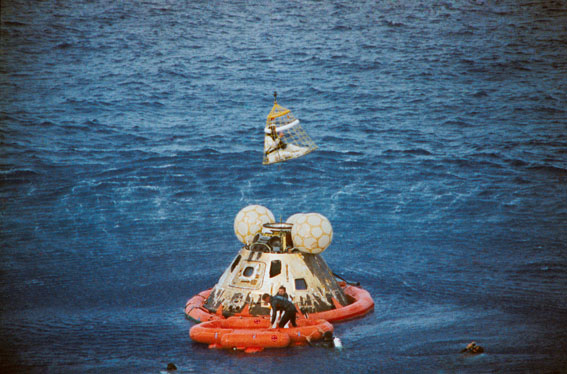
Jack Swigert going up.
143:28:11 Relay: The rescue net is at the cargo hatch, and the second astronaut is safely aboard.
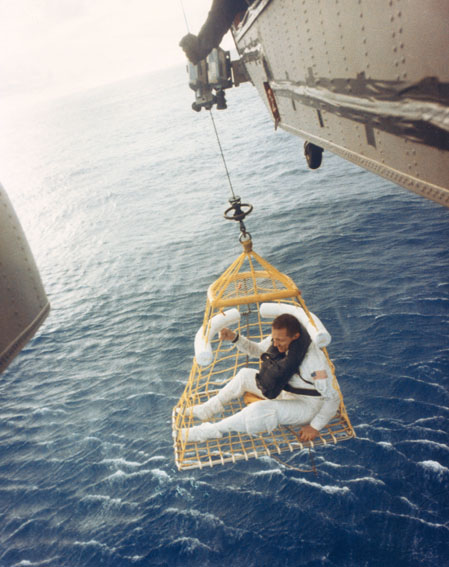
Jack Swigert hoisted to the rescue chopper.
143:28:20 Recovery: This is Recovery. I have astronaut Swigert onboard. He reports he feels fine.
143:28:28 Iwo Jima: Iwo Jima, copy. [Long pause.]
143:28:52 Relay: Recovery is manuevering for position. For the third retrieval. [Pause.]
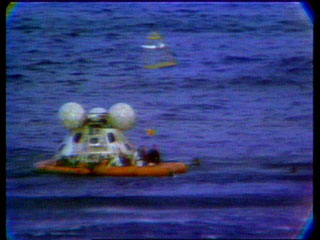
The rescue net being moved to the egress raft for Jim Lovell. The Captain leaves last.
143:29:08 Relay: Swim leader has the rescue net. It is positioned aboard the platform.
143:29:22 Relay: The third astronaut is climbing aboard, it is thumbs up, ready to lift. [Pause.]
143:29:36 Relay: The third astronaut is on his way up. [Pause.]
143:29:48 Relay: The third astronaut is half way up. [Pause.]
143:29:59 Relay: The third astronaut is nearing the cargo hatch. He is safely aboard. [Pause.]
143:30:15 Recovery: This is recovery. I have Capt. Lovell aboard. He reports he feels fine. Over.
143:30:20 Iwo Jima: Iwo Jima, Copy. [Garble].
143:30:23 Recovery: [Garble] starboard [garble]. [Pause.]
143:32:09 Recovery: [Garble] this is Recovery. You are clear to deploy your [garble] one.
143:32:12 Recovery: Roger, Roger. [Long pause.]
143:32:49 Iwo Jima: Recovery and Photo, this is Iwo Jima towers. Report your gear and you have charlie on spots 3 and 5. Your wind is 10 starboard and at 10 knots.
143:33:00 Recovery: This is Recovery. Roger. Copied. Be advised I'll make a wide circle in order to allow the passengers to get into their flight suits.
143:33:10 Iwo Jima: Roger Recovery.
143:35:12 Unknown speaker: [Garble] FAO.
143:35:14 Unknown speaker: Hey, I'd like to update this [garble]. [Long pause.]
143:35:29 Recovery: Iwo tower, this is [garble]. We - this is Recovery. We estimate we'll be ready to touch down in 4 minutes, 4 minutes away.
143:35:39 Iwo Jima: Recovery, tower. Roger. [Long pause.]
143:36:24 Iwo Jima: Recovery, this is Iwo Jima tower. Pass to Captain Lovell that we will have a brief ceremony on the flight deck then they will be talking to their wives [garble] in sick bay. Over.
143:36:36 Recovery: Iwo Tower, Recovery, Roger will do.
Here in the Mission Control Center, the tempo of conversation has picked up considerably. That's one thing you normally do not hear, is loud voices but they are certainly loud and happy voices at this point.
143:37:48 Recovery: [Garble] Apollo 13.
143:37:55 Iwo Jima: Roger, you're at [garble] Charlie at 3 by [garble] to Recovery to 11.
143:38:01 Recovery: Recovery, Roger out.
143:38:02 Unknown speaker: [Garble] photo wants to [garble].
143:38:04 Iwo Jima: Iwo tower, Roger, your charlie [garble] your [garble]. [Long pause.]
As we look around the room we see a large representation of the astronaut corps. Donald K. Slayton of course is here. He's been here all night. Alan Shepard, Commander for Apollo 14, and Joe Engle is here, Tom Stafford, Chief of the Astronaut Office, Vance Brand, who served as a support crew member for Apollo 13.
143:38:43 Iwo Jima: Which swim aircraft remains out?
143:38:47 Recovery: This is Recovery. Negative [garble].
143:38:51 Iwo Jima: Roger, Swim 1, we're moving in. You babies ready?
143:38:56 Unknown speaker: [Garble]. [Long pause.]
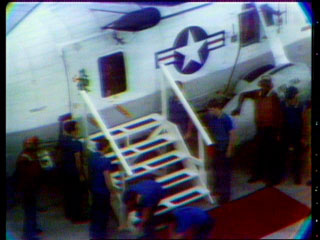
The rescue helicopter has landed, and a red carpet is being rolled out for the crew.
Gene Cernan, backup Commander for Apollo 14 is here, Tony England, who served as the scientist for the Apollo 13 crew is in the room at this time as is John Young.
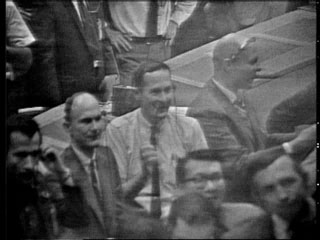
A black and white TV image captures the cheering Mission Control, including Ken Mattingly.
143:39:24 Iwo Jima: [Garble] Rescue 1. [Long pause.]
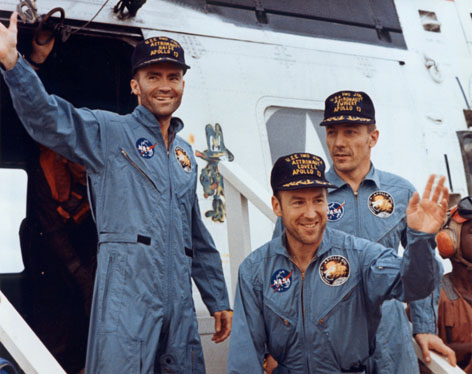
Lovell, Swigert and Haise greet the crew of Iwo Jima from the helicopter steps.
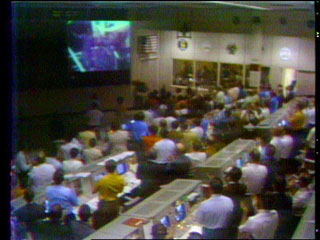
The exact moment the picture above was taken, as seen in Mission Control.
143:39:46 Unknown speaker: to give you a hearty "well done". [Long pause.]
143:40:35 Iwo Jima: [Garble] 13.
143:40:39 Recovery: Roger out. [Long pause.]
143:41:03 Unknown speaker: [Garble]. [Long pause.]
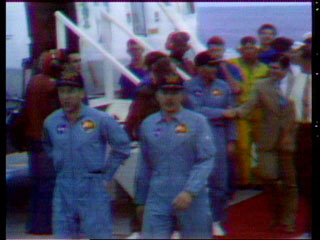
Eager officials and crew meet the astronauts as they walk along the red carpet to greet the Commanding Officer of the carrier.
The applause you just heard in the Mission Control Center came from a message delivered by Administrator Thomas Paine over the Flight Director's loop congratulating - from the President of the United States congratulating the team of Apollo 13.
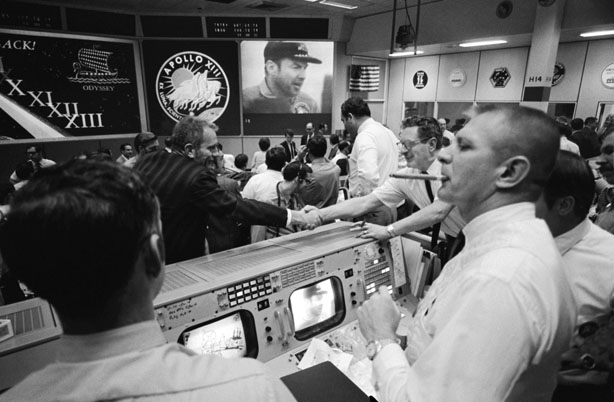
Celebratory cigars in Mission Control. Live TV from the Iwo Jima is projected on the big screen.
143:41:17 Unknown Speaker: [Garble]. [Pause.]
143:41:26 Unknown Speaker: [Garble] net 1. Over.
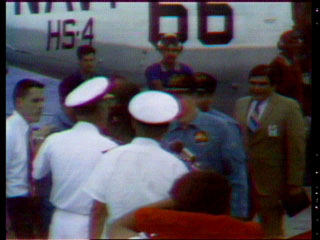
The crew greeted by commanding officers of the USS Iwo Jima and the recovery task force.
143:42:54 Iwo Jima: I want to commend you on your navigation. Welcome onboard the Iwo Jima.
143:43:02 Iwo Jima: I would like to ask the Chaplain to say a real brief prayer of thanks.
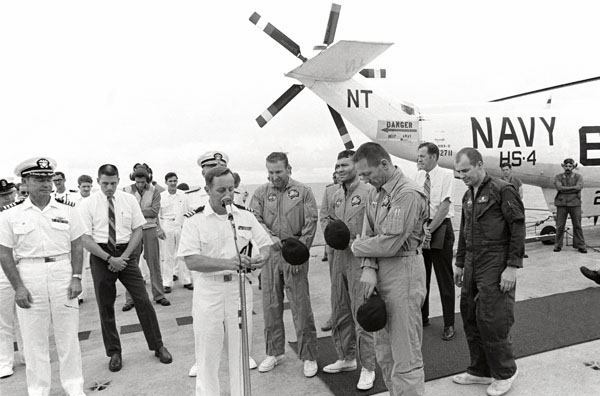
Photograph of the prayer for the safe return of the crew. Ship's Chaplain, Commander Philip E. Jerauld officiating.
143:43:08 Chaplain Jerauld: Let us pray. Oh Lord, we joyfully welcome back to Earth astronauts Lovell, Haise, and Swigert. Who by your grace, their skill, and the skill of many men survived the dangers encountered in their mission and returned to Earth, safe and whole. We offer our humble thanksgiving for the successful recovery. Amen.
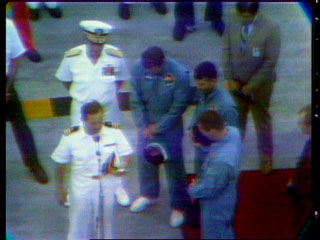
Video capture of the prayer, from the TV stream.
143:43:41 Photo: Now for some additional picture taking. Might not only be professional phographers aboard but also a good many ...
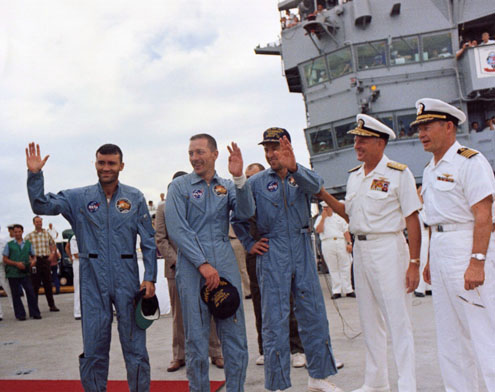
One of the many photos of the crew posing on the deck.
143:43:57 Speaker: [Garble].
143:45:02 Speaker: Down into the sick bay, medical facility now for 3 hours, of physical examinations. Now they're on the elevator there now. Joking about those beards. Jim Lovell seemed to be having some fun there with his beard. A momentary wait on the elevator here while the photographers get a few more pictures. This is an elaborate medical facility the Iwo Jima has onboard. And, as we said, there will be nine doctors down there awaiting Jim Lovell, John Swigert and Fred Haise. That's 3 doctors to an astronaut. And the first two flip samples, the findings medically speaking will be flown off as soon as possible, to the laboratories. I've been getting a look from the hangar deck of the elevator, who's down from top side. The elevator they use of course to transport the helicopters from hangar deck to flight deck. Once they get down they'll have a fairly short walk, maybe 30 or 40 yards over into the - an opening leading up the medical facility. Sick bay, which may be a misnomer in this case. It does not appear anybody is sick. That's Captain Kirkemo - I know that is. And of course there will be some fast telephone calls we assume to some waiting wives at home. I wouldn't be surprised to see those phones ringing very shortly. There they go. Into the entrance of the medical facility and that should be all we see of them now for the next 3 hours or so, and possibly get an early medical report on what their conditions indeed are. But - the Apollo 13 men home safely aboard the carrier Iwo Jima out here; a perfect recovery; it couldn't have been better - it couldn't...
This is Apollo Control, Houston, at the Mission Operations Control Room; there must be almost 200 people at this point and it appears as though everybody is talking, shaking hands, the cigars have been passed out...
143:50:08 Iwo Jima: [Garble] on display down here now. I have here with me right now Commander Spiuey. I'm prepared to put Commander Spiuey on the air as soon as he gets here in a couple of minutes. I would - we appreciate ... [Garble]
The plaque for Apollo 13 has just been placed on the wall in the Mission Control Room; that brought about this loud applause we just heard. [Cheering and applause.]
This is Apollo Control, Houston; we expect to have 3 news conferences picking up shortly in the Bldg. 1 auditorium, the first starting in approximately 30 minutes with NASA Administrator Thomas Paine and Deputy Administrator George Low, this will be followed approximately 30 minutes later involving Dale Myers, Associate Administrator for Manned Spaceflight, and Dr. Gilruth, Robert Gilruth, Director of the Manned Spacecraft Center, Mr. Rocco Petrone, Apollo Program Director, Jim McDivitt, Manager of the Apollo Spacecraft Program Office at the Manned Spacecraft Center in Houston, and Mr. Chris Kraft, Deputy Director at MSC. Following that will be a third news conference with Mission Director Chet Lee, Director of Flight Operations, Sig Sjoberg, and Lead Flight Director for this mission, Milt Windler, and Mr. Ozzie [Ozro] Covington, of the Goddard Spaceflight Center. We copied splashdown at 142 hours, 54 minutes, 44 seconds from liftoff, and this is Apollo Control, Houston, signing off at this time.
END OF TRANSCRIPTION.


